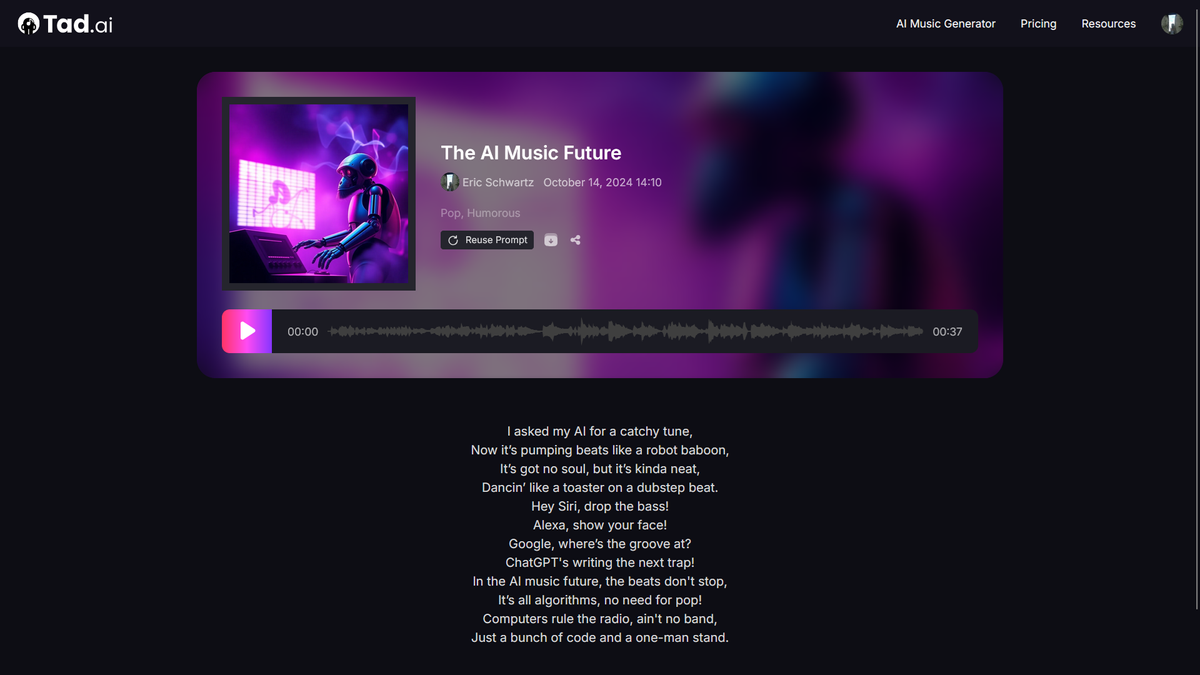Do you have an idea for a song but are not sure how to write it? Maybe you just have some lyrics you want to put a tune to? A new free AI music generator called Tad AI offers you a chance to bring those ideas to life, producing royalty-free songs in seconds with minimal input. The relatively simple interface produces some pretty impressive results. Whether it can thread the needle and avoid the issues causing legal and ethical headaches for Suno, Udio, and other AI music generators remains to be seen.
Tad AI provides various levels of assistance in writing music. It’s similar to its rivals but is notably intuitive in how you produce the song. You can describe how you want the song to sound in as much detail as you choose, but Tad AI does have quite a lot of musical genres and moods you can select from that are already available. The genre options obviously relate to the genre of the tune, but the mood-based list of options can vary the tone within that genre, as a rock or rap song could be sad, romantic, or angry while still being the same genre.
Along with the music, you can also ask Tad AI to write lyrics that match a written prompt. The AI will produce the lyrics based on your intent or the theme. You can also write your own lyrics. Then, you just need a title, and the AI will do the rest.
After playing around with it for a bit, I produced the song below. The music is all Tad AI, but I wrote the lyrics after the first few attempts by Tad AI didn’t really hit the spot for me. They did inspire me though, and if Tad AI was a human, I’d co-credit them with the arrangement at least and probably have to negotiate over lyric rights. You can listen to it below and hear it at this link.
Royalty (and lawsuit) free?
As AI music generators become more prominent and roll out new features like Suno’s genre remixer and its mobile app, the issue of lawsuits from major music labels is only likely to get more complex. That’s why one of the major selling points for Tad AI is its ability to generate royalty-free music if you sign up for its paid plans. If Tad AI’s promise of 100% original compositions is backed up fully, the appeal to aspiring music creators, not to mention brands on a budget, is obvious.
Songs without potential legal challenges or licensing fees are music to the ears of those looking to save on costs. It might even be helpful with existing content on platforms like YouTube, which recently launched a tool that can remove copyrighted music from your video without taking it down completely. You could instead replace it with something from Tad AI.
You can use Tad AI for free, though you only get a limited number of credits, and each song costs about five credits. If you want more, you can sign up for the basic plan at $10 a month and get 1,000 credits, about 200 songs, and three concurrent songs produced. The Pro plan for $30 a month gets you 3,000 credits, six concurrent songs produced and even faster song generation. You have to pay for the full royalty-free track access, so that’s probably where anyone looking to use the tool professionally will go.










































































































































You must be logged in to post a comment Login